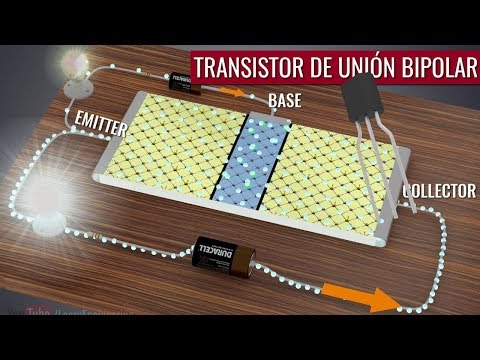How current flow works in a transistor
Hello to all electronics enthusiasts! Are you ready to enter the wonderful world of transistors? Today we will talk about how current flow works in these small but powerful devices. As an electronics engineer and programming lover, I know how exciting it is to understand how electronic components work and how they affect our digital world. So hold on to your seats, turn on your brains and prepare for a journey of transistor knowledge. Let's get started!
Understanding current flow in a transistor: Everything you need to know
The flow of current in a transistor is a fundamental topic in electronics. Below is a complete guide on how this current flow works in a transistor and everything you need to know.
- What is a transistor:
A transistor is an electronic device used to control the flow of current in a circuit. It is capable of amplifying and switching electrical signals. The transistor is composed of three layers of semiconductor material: a P-type layer between two N-type layers (NPN transistor) or an N-type layer between two P-type layers (PNP transistor).
- General Transistor Operation:
The transistor works as a kind of electrical switch controlled by an input signal. When the input signal is low, the transistor is off and does not conduct current. When the input signal is high, the transistor turns on and allows current to flow through it.
- Types of current flow in a transistor:
There are two types of current flow in a transistor:
- Emitter to Collector Current Flow (NPN Transistor): In this type of transistor, current flows from the N-type layer of the emitter to the N-type layer of the collector.
- Collector to Emitter Current Flow (PNP Transistor): In this type of transistor, current flows from the P-type layer of the collector to the P-type layer of the emitter.
- Transistor operating modes:
There are three modes of transistor operation:
- Cut-Off: In this mode, the transistor is off and there is no current flow through it.
- Saturation: In this mode, the transistor is on and there is maximum current flow through it.
- Active: In this mode, the transistor is on and there is a variable current flow through it.
- Transistor characteristic curve:
The transistor characteristic curve is a graphical representation of the relationship between the input current and the output current of the transistor. This curve allows us to know the behavior of the transistor in different operating conditions.
- Transistor Applications:
The transistor is used in a wide variety of electronic applications, such as audio amplifiers, oscillators, power supplies, electronic switches, among others.
In summary, the flow of current in a transistor is a fundamental concept in electronics and knowing how it works is essential to understanding electronic circuits. We hope this guide has been helpful in understanding everything you need to know about current flow in a transistor.
Know the basic operation of a transistor in electronics
The transistor is a very important electronic component in modern electronics. Its basic operation is to control the flow of current through a region of semiconductor material. The current flow can be controlled by a signal applied to the control region of the transistor.
The transistor has three regions: emitter, base and collector. Current flows from the emitter to the collector, and its magnitude can be controlled by the signal applied to the base.
Next, the operation of current flow in an NPN type transistor will be explained:
- The emitter region is doped with a material that has extra electrons, meaning it has a negative charge.
- The base region is very thin and is doped with a P-type material, which has a positive charge. When a signal is applied to the base, electrons begin to move from the emitter to the base.
- The collector region is doped with an N-type material, meaning it has a negative charge. Electrons that reached the base are attracted to the collector, which increases the current flow.
It is important to note that the current flow in a transistor is controlled by the signal applied to the base. If the signal is too small, the transistor will be in cut-off mode and there will be no current flow. If the signal is large enough, the transistor will be in saturation mode and current flow will be maximum.
In summary, the transistor is a very important electronic component in modern electronics and its basic operation is to control the flow of current through a region of semiconductor material. The current flow can be controlled by a signal applied to the control region of the transistor.
Understanding Current Flow in an NPN Transistor: A Practical Guide for Electronics Engineers and Programmers.
How current flow works in a transistor:
A transistor is an electronic component that is used to amplify or change the electrical current signal. The current flow in an NPN (Negative-Positive-Negative) transistor can be understood as follows:
- When a positive voltage is applied to the base terminal, electrons flow from the emitter to the base of the transistor.
- These electrons combine with the holes (vacancy) present in the base, producing a base current.
- This base current activates the transistor and allows current to flow from the collector to the emitter.
- The amount of current that flows from the collector to the emitter depends on the base current and the gain of the transistor.
- A small base current can control a much larger current flowing from the collector to the emitter.
NPN Transistor Symbol Table:
| Port | Symbol | Description |
|---|---|---|
| Transmitter |  |
Terminal from which the electron current flows. |
| Base | <img decoding="async" src="https://i.imgur.com/5p5wXtW. png» alt=»Base»> |
Terminal that controls the flow of current between the emitter and the collector. |
| Manifold |  |
Terminal where the current of electrons that come from the emitter flows. |
In summary, understanding current flow in an NPN transistor is essential for electronic engineers and programmers working with electronics. With this practical guide, we hope to have provided an overview of the operation of current flow in an NPN transistor and to have provided valuable information for the design and implementation of electronic circuits.
Understand how a transistor works: Complete guide for beginners in electronics.
Understand how a transistor works: Complete guide for beginners in electronics
Transistors are basic electronic components used in a wide variety of electronic applications. In this guide, we will explain how a transistor works and how you can use it in your electronic projects.
1. What is a transistor?
A transistor is an electronic component used to amplify or switch electrical signals. The term transistor comes from the contraction of the words transfer resistor, which means that it is a device that transfers resistance from one material to another.
2. Types of transistors
There are two main types of transistors: bipolar junction transistors (BJT) and field effect transistors (FET). BJTs are the most common and are used in a wide variety of applications. FETs, on the other hand, are primarily used in high-frequency applications.
3. Structure of a transistor
A transistor is made up of three layers of semiconductor material: the base layer, the emitter layer, and the collector layer. The base layer is located between the emitter layer and the collector layer.
4. Operation of current flow in a transistor
The current flow in a transistor is controlled by applying an external voltage to the base. When a positive voltage is applied to the base, a flow of electrons occurs from the emitter to the base. This flow of electrons creates an electric field that allows electrons to flow from the collector to the emitter.
5. Signal amplification with a transistor
Signal amplification with a transistor is achieved by controlling the current flowing through the collector layer. The base current controls the collector current, which allows the signal in the circuit to be amplified.
6. Switching signals with a transistor
Switching signals with a transistor is achieved by controlling the current flow in the base. When the base current is zero, the transistor is in the cut-off state and there is no current flow in the circuit. When the base current is greater than zero, the transistor is in saturation state and there is maximum current flow in the circuit.
In summary, transistors are essential electronic components used in a wide variety of electronics applications. We hope this guide has helped you understand how a transistor works and how you can use it in your projects.
Learn about the different types of transistors and their applications in electronics
How current flow works in a transistor
Transistors are electronic components used to control the flow of current in a circuit. There are different types of transistors, each with specific characteristics and applications. The three most common types and their uses in electronics are detailed below.
1. Bipolar Junction Transistor (BJT)
The BJT is the most commonly used type of transistor. It is made up of three regions: the base, the collector and the emitter. Current flows through the collector and out the emitter, but only if there is current flowing to the base. The BJT is used in amplifiers, oscillators and switches.
2. Field Effect Transistor (FET)
The FET is a type of transistor that uses an electric field to control the flow of current. It is composed of a channel region and a gate that controls the flow of current. The FET is used in signal amplifiers, oscillators and switches.
3. Junction Field Effect Transistor (JFET)
The JFET is similar to the FET, but uses a PN junction to control current flow. Current flows from the channel to the drain, and the amount of current is controlled by the voltage applied to the gate. The JFET is used in signal amplifiers, oscillators and switches.
Comparative table of the different types of transistors:
| Transistor | Operation | Applications |
|---|---|---|
| BJT | Controls current flow through the base | Amplifiers, oscillators, switches |
| Fet | Controls the flow of current using an electric field | Signal amplifiers, oscillators, switches |
| JFETs | Controls current flow through a PN junction | Signal amplifiers, oscillators, switches |
And that's how current flow works in a transistor! I hope you have enjoyed this journey through the world of electronics. If you have any questions or comments, feel free to leave them below! Until next time!




Post Comment